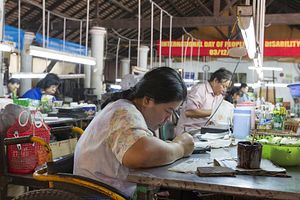In the U.S., investors are drawn to different states for different reasons. While such preferences seem to be a no-brainer, foreign investors in Vietnam often make the mistake of all congregating around a small handful of provinces. This misses the fact that Vietnam comprises 63 diverse provinces that compete vigorously with each other for foreign capital and offer vastly different advantages to foreign firms in different industries.
Vietnam has become a must-go-to destination for international manufacturers in many industries, and the country has hosted thousands of foreign investment projects worth more than $111.7 billion between 1998 and 2013. More and more multinational companies are looking toward Vietnam, as the Southeast Asian nation boasts cheap, eager and readily available labor, a safe and secure environment, and political stability.
Unfortunately, investors prefer what they already know, instead of what they – often unfairly – label “risky.” That means investors are missing out, as the risks are quite manageable with the right background knowledge about the various locations.
The United States Agency for International Development in cooperation with the Vietnam Chamber of Commerce & Industry publish an annual Provincial Competitiveness Index. In it, provinces are ranked rigorously (the lead investigator is a well-known American Vietnam scholar) along a number of indicators, like corruption, business support services, entry cost, time cost or transparency. A composite index then ranks all 63 provinces, giving investors a good idea what to expect.
Of course, different industries need different business environments, and not all provinces are equally suitable for a chemical manufacturer, a garment assembly line, or a computer chip facility.
In 2013, the urban provinces of Da Nang and Hue topped the ranking, combining urban infrastructure with much lower cost of living than Hanoi or Ho Chi Minh City. Number three and four on the ranking go to a province near Ho Chi Minh City and one near Hanoi and the port of Haiphong.
The reason for the performance gap among provinces dates back to the way the Vietnamese government structured its market reforms known as Doi Moi (Renovation) in 1986. Knowing it could not build up the entire backward country at the same time, the ruling Party decided to focus on a small part of the country first. Moreover, the leadership did not trust the monumental changes from the start and made sure the first foreign investors were located far away from the political capital Hanoi – in and around the Southern city of Ho Chi Minh City, the former Saigon.
This artificial separation between the political center in the North and the economic one in the South is still visible today. The Southeastern region around Ho Chi Minh City enjoys the country’s best infrastructure, and after at least two decades of strong investment performance attracts many of the most motivated, entrepreneurial migrants.
As a result, foreign investors thinking about setting up shop in Vietnam look toward Ho Chi Minh City, and the Government Statistics Office reports that in 2011, six out of 10 foreign-invested firms were located in the Southeast region.
After two decades of rapid growth, Ho Chi Minh City has become a metropolis with all the trappings of an economic and financial center – including traffic jams, sky-high rents, and a cost of living that requires rapidly increasing salaries. Garment factories are squeezed into a slew of industrial parks along all major traffic arteries entering the city. When shifts change, a tsunami of motorbikes floods the roads.
This human flood taxes local infrastructure, and the city’s governments and neighboring Dong Nai and Binh Duong are actively discouraging new investments in low-added-value factories.
City officials say they want to see these factories go to nearby provinces, while fostering research, design, financing and other, higher-end support industries in Ho Chi Minh City. To that end, they support highway construction into adjacent Long An province, to make sure labor-intensive industries stay close enough to make Ho Chi Minh City their corporate homes while doing the cheap labor outside the expensive city.
This policy mirrors the Asian development experience known as the Flying Geese model. As one country becomes too expensive to produce a low-end product, it outsources it to others with cheaper labor. Japan, for example, outsourced transistor radios to Taiwan and Korea; as these economies developed, they outsourced it to the next emerging economies, Thailand and Malaysia. In Vietnam, the process takes place domestically, among provinces.
The central government is on message as well. Its goal has always been to develop target areas, then distribute the gains to other areas. Now it makes available generous tax holidays and low-cost land in well-developed industrial parks to companies that invest in certain target industries or target areas. A labor-intensive factory misses out on the best incentives Vietnam has to offer if it follows the crowd into expensive – and not tax-favored – Ho Chi Minh City.
One of the reasons to locate in the growth poles has been labor availability. The concentration of industrial park attracted a large number of workers. Recently, however, the cost of living in these areas has driven workers back home – Vietnam has a large wave of return migration. Most provinces that used to lose their young and able workers to the economic growth areas can now offer returnees, who are accustomed to factory work and were trained in Ho Chi Minh City’s industrial zones.
Using rankings such as the PCI and a good consultant with connections on the ground can make the difference between simply investing in Vietnam – and taking advantage of the varied advantages Vietnam offers different industries with a wide range of needs.
This article originally appeared in Borderless News.
Thomas Jandl is an Asia consultant and expert on the investment advantages of Vietnam’s diverse provinces. He is a former assistant professor and Scholar-in-Residence at American University in Washington DC and author of Vietnam in the Global Economy: The Dynamics of Integration, Decentralization and Contested Politics. He can be reached at [email protected].

































